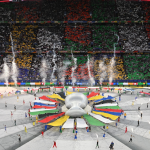
At Euro2024 VAR is explained
For the first time, spectators in the stadium will be able to follow the referee's decisions in real time
June 17th, 2024
One of the innovations introduced by UEFA for Euro2024 is a different version of VAR. More specifically, the federation has decided to meet the needs of the fans at the stadium by working on a communication level. Until today, the biggest problem with decisions taken thanks to the help of VAR did not concern the people at home. That's because fans at the bar or on the couch can always rely on the voice of the commentators to be driven step by step in every situation. VAR’s real problem involved the fans at the stadium: unless there are obvious situations, for instance a possible offside to be checked after a goal, people at stadiums are lost when the game is stopped and it is hard for them to understand the reason why referees are called by VAR and why they changed their minds. Fans are helpless and they can not have legit thoughts about the episode that needs to be checked, they can only react once the referee has taken his decision and they only have two moods: happy or angry depending if the decision is in their favor or not.
How VAR is made clearer for fans - just explaining decisions now #euro2024 pic.twitter.com/yoWSMhPfOX
— Rob Harris (@RobHarris) June 14, 2024
For this reason UEFA for Euro 2024 has decided to help fans at the stadium in understanding what is going on by introducing messages on the jumbotrons. To be more precise, whenever VAR interrupts the game, a message appears on the screens to provide a brief explanation for each decision. This offers a more thorough explanation than the small banners that notify viewers at home. The reason for this is that fans at the stadium cannot trust commentators to deliver all the essential information like they do for viewers at home. The first example came in the very first game of the tournament, Germany-Scotland, when a penalty kick was awarded to Germany and then canceled by the VAR. When the referee took his decision, a message popped up on the big screen: “Penalty cancelled. Foul was committed by Scotland's No.11 outside the penalty area”. It's a small but significant advancement that UEFA has been eagerly pushing for, a really appreciated aesthetic and communicative detail.
Nevertheless, it’s too early to imagine this solution to be adopted in all the major European leagues. At the same time it can not be ruled out that from now on, this new way of explaining VAR could be introduced by UEFA in Champions Leagues’s games. It is obvious that we are still a considerable distance away from referees engaging with fans by explaining their decisions, not just conferring with players. This is a common practice in the American professional sports, especially in the NFL, but more recently even the NBA adopted this solution after a first experiment during the pandemic. Football is slowly going towards that direction: in the Portuguese league last March there has been a first experiment approved by IFAB while on an international level FIFA has already introduced this option during the Club’s World Cup played in Morocco in February 2023. Everyone involved is keen to improve the understanding and enjoyment of football, and that's why updates on the potential introduction of VAR for coaches are anticipated in the upcoming weeks.












